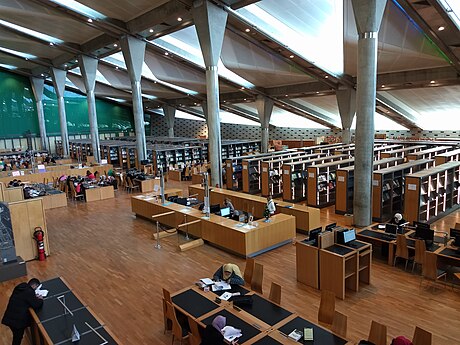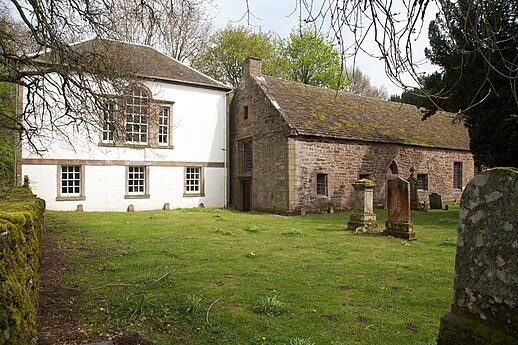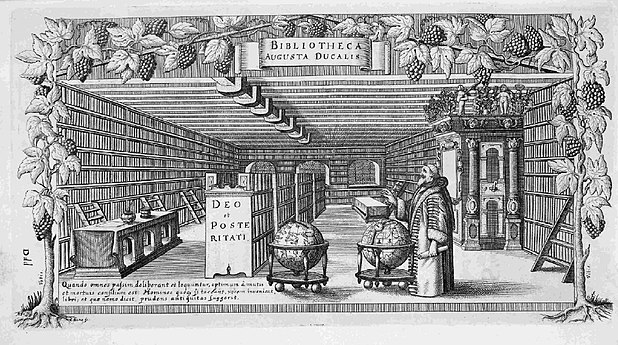Wikipedia:Wikipedia Signpost/2022-08-01/Serendipity
The Library
One of the best books published last year is the book The Library. A Fragile History by Andrew Pettegree and Arthur der Weduwen. It is a scholarly book, with a 16 page index and 787 notes, but it is lightly written and very readable. It contains 18 chapters, mostly dedicated to a particular subject like “Idle Books and Riff Raff” (from Oxford to Franeker), “Cardinal Errors” (about Richelieu) and “Reading on the Job” (with the Carnegie story). The authors, both researchers at the University of St. Andrews in Scotland, succeed in painting a clear picture of the history of the library as such, in only 518 pages, drawn upon some outstanding examples. True, they forgot most Asian and African libraries (6 pages on China, 3 on Japan, 1 on Timbuktu), but these will be dealt with in a new book, I presume.
Sum of all knowledge? But "not considered to be a reliable source"
Wikipedia is the Library of the 21st century. At least, it aspires to be, and to give “free access to the sum of all human knowledge” is a clear goal. Though Wikipedia is a tremendous tool of knowledge, Wiki is only starting to summarize some of the knowledge in the world. But it is a start, and I wouldn’t have dedicated ten thousand hours of my life to Wikipedia if I wouldn’t have been convinced that it will prove to be a useful library – somewhere in the future.
Wikipedia has five pillars and a content policy, which states that articles may not contain original research. Rightly so. That makes understandable why universities advise students NOT to cite Wikipedia: scholars should learn to cite the original source, not a shortened and simplified version of it in Wikipedia. Most universities (for example, this one) therefore advise to use the sources and literature references in Wikipedia, but not the text in Wikipedia itself. It comes as no surprise, that Wikipedia advises the same: “Wikipedia is not considered to be a reliable source as not everything in Wikipedia is accurate, comprehensive, or unbiased.”
Usage of images from Commons
Wikimedia Commons is a different story. I read the book The Library. A Fragile History, which contained 52 images. Ten of these images (so roughly 20%) were library photographs taken from Wikimedia Commons (see below). Another ten were probably also indirectly taken from Commons, but the original source was given (again: rightly so). It is only logical that scholars use Wikimedia Commons for recent photographs from libraries in Egypt, Turkey, Austria, San Francisco and Manchester. More interesting is to see that three of the images were taken from library collections: no. 3 (Codex Amiatinus), no 8 (National Gallery of Art, Washington) and no. 9 (Braunschweig). The image from the National Gallery of Art was donated during a Wiki Commons project of the NGA. The Braunschweig image was originally uploaded from the website of Arbeitsgemeinschaft historischer Forschungseinrichtungen, closed down in 2013.
Needless to say that photographs like this file wouldn’t have been used in this book if they hadn’t been uploaded by the Dutch Heritage Foundation RCE to Commons in 2013. Any other conclusions? Well, cooperation pays off, and Libraries and Museums are right in working together with Wikimedia Commons - and good photos might end up in books.
10 images from Commons used in The Library. A Fragile History (2021)
- Bibliotheca Alexandrina (2018)
(photo by Cecioka) - Library of Celsus (2011)
(photo by Benh Lieu Song) - Codex Amiatinus, 8th c. (Florence)
- Bodleian Library (2015)
(photo by David Iliff) - Admont Abbey Library (2011)
(photo by Jorge Royan) - San Francisco Public Library (2009)
(photo by Joe Mabel) - Innerpeffray Library (2018)
(photo by Tom Parnell) - Gabriel Naudé
(National Gallery of Art Washington) - The Portico Library, Manchester (2016)
(photo by Michael D Beckwith)














Discuss this story